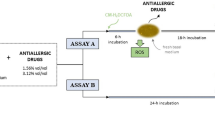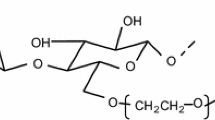Abstract
Purpose
2-Methacryloyloxyethyl phosphorylcholine (MPC) polymer is a multifunctional agent with antiadhesive, antithrombogenetic, and strong hydrating properties. MPC polymer-containing eye drops are the first such ophthalmic product to be commercially available; they contain approximately 0.1% Lipidure-PMB (copolymer of MPC and butyl methacrylate; NOF Corporation, Tokyo, Japan). This study evaluated the cytotoxicity of this new product toward ocular surface cells.
Methods
SIRC (rabbit cornea), BCE C/D-1b (bovine cornea), RC-1 (rabbit cornea), and Chang (human conjunctiva) cell lines were tested in this study. Cell viability was measured using both the MTT assay and the neutral red test in cells treated for 10, 30, or 60 min with MPC-containing eye drops and 4 commercial ophthalmic solutions containing sodium hyaluronate (SH) at various doses (undiluted, twofold diluted, and tenfold diluted). Cell viability scores were calculated. Cell viability was analyzed using ANOVA and the Dunnett test.
Results
After treatment with the MPC eye drops, cell viability rates were maintained at over 80% irrespective of the cell lines, dilution rates, exposure times, and assays, and were similar to those of the clinically approved artificial tear products other than Hyalein 0.1%, although some significant differences were found.
Conclusions
The MPC eye drops were tolerable to ocular surface cells, and comparable to single doses of clinically approved drugs containing sodium hyaluronate.


Similar content being viewed by others
References
Epidemiology Subcommittee of the International Dry Eye WorkShop. The epidemiology of dry eye disease: report of the Epidemiology Subcommittee of the International Dry Eye WorkShop (2007). Ocul Surf. 2007;5:93–107.
Epidemiology Subcommittee of the International Dry Eye WorkShop. The definition and classification of dry eye disease: report of the Epidemiology Subcommittee of the International Dry Eye WorkShop (2007). Ocul Surf. 2007;5:75–92.
Furrer P, Mayer JM, Gurny R. Ocular tolerance of preservatives and alternatives. Eur J Pharm Biopharm. 2002;53:263–80.
Baudoiun C, Labbé A, Liang H, Pauly A, Brignole-Baudouin F. Preservatives in eyedrops: the good, the bad and the ugly. Prog Retin Eye Res. 2010;29:312–34.
Tsubota K. Tear dynamics and dry eye. Prog Retin Eye Res. 1998;17:565–96.
Burnstein NL. The effect of topical drugs and preservatives on the tears and corneal epithelium in dry eye. Trans Ophthalmol Soc UK. 1985;104:402–9.
Khanal S, Tomlinson A, McFadyen A, Diaper C, Ramaesh K. Dry eye diagnosis. Inv Ophthalmol Vis Sci. 2008;49:1407–14.
Ishihara K, Aragaki R, Ueda T, Watenabe A, Nakabayashi N. Reduced thrombogenicity of polymers having phospholipid polar groups. J Biomed Mater Res. 1990;24:1069–77.
Ishihara K, Takai M. Bioinspired interface for nanobiodevices based on phospholipid polymer chemistry. J R Soc Interface. 2009;6 Suppl 3:S279–91.
Ishihara K. Bioinspired phospholipid polymer biomaterials for making high performance artificial organs. Sci Technol Adv Mater. 2000;1:131–8.
Ishihara K. New polymeric biomaterials—phospholipid polymers with a biocompatible surface. Front Med Biol Eng. 2000;10:83–95.
Iwasaki Y, Sawada S, Nakabayashi N, Khang G, Lee HB. Ishihara K. The effect of the chemical structure of the phospholipid polymer on fibronectin adsorption and fibroblast adhesion on the gradient phospholipid surface. Biomaterials. 1999;20:2185–91.
Ishihara K, Ishikawa E, Iwasaki Y, Nakabayashi N. Inhibition of fibroblast cell adhesion on substrate by coating 2-methacryloyloxyethyl phosphorylcholine polymers. J Biomater Sci Polymer Ed. 1999;10:1047–61.
Ye SH, Watanabe J, Iwasaki Y, Ishihara K. Antifouling blood purification membrane composed of cellulose acetate and phospholipid polymer. Biomaterials. 2003;24:4143–52.
Sawada S, Sakaki S, Iwasaki Y, Nakabayashi N. Ishihara K. Suppression of the inflammatory response from adherent cells on phospholipid polymers. J Biomed Mater Res A. 2003;64:411–6.
Iwasaki Y, Sawada S, Ishihara K, Khang G, Lee HB. Reduction of surface-induced inflammatory reaction on PLGA/MPC polymer blend. Biomaterials. 2002;23:3897–903.
Goda T, Matsuno R, Konno T, Takai M, Ishihara K. Protein adsorption resistance and oxygen permeability of chemically crosslinked phospholipid polymer hydrogel for ophthalmologic biomaterials. J Biomed Mater Res B Appl Biomater. 2009;89:184–90.
Goda T, Ishihara K. Soft contact lens biomaterials from bioinspired phospholipid polymers. Expert Rev Med Devices. 2006;3:167–74.
Okajima Y, Saika S, Sawa M. Effect of surface coating an acrylic intraocular lens with poly(2-methacryloyloxyethyl phosphorylcholine) polymer on lens epithelial cell line behavior. J Cataract Refract Surg. 2006;32:666–71.
Liu W, Deng C, McLaughlin CR, Fagerholm P, Lagali NS, Heyne B, et al. Collagen-phosphorylcholine interpenetrating network hydrogels as corneal substitutes. Biomaterials. 2009;30:1551–9.
Polack FM, McNiece MT. The treatment of dry eye with Na hyaluronate (Healon). Cornea. 1982;1:133–6.
Yokoi N, Komuro A, Nishida K, Kinoshita S. Effectiveness of hyaluronan on corneal epithelial barrier function in dry eye. Br J Ophthalmol. 1997;81:533–6.
Nakamura M, Sato N, Chikama TI, Hasegawa Y, Nishida T. Hyaluronan facilitates corneal epithelial wound healing in diabetic rats. Exp Eye Res. 1997;64:1043–50.
Johnson ME, Murphy PJ, Boulton M. Effectiveness of sodium hyaluronate eyedrops in the treatment of dry eye. Graefes Arch Clin Exp Ophthalmol. 2006;244:109–12.
Troiano P, Monaco G. Effect of hypotonic 0.4% SH drops in dry eye patients: a cross-over study. Cornea. 2008;27:1126–30.
Debbasch C, De La Salle SB, Brignole F, Rat P, Warnet JM, Baudouin C. Cytoprotective effects of SH and Carbomer 934P in ocular surface epithelial cells. Invest Ophthalmol Vis Sci. 2002;43:3409–15.
Burstein NL, Klyce SD. Electrophysiologic and morphologic effects of ophthalmic preparations on rabbit cornea epithelium. Invest Ophthalmol Vis Sci. 1977;16:899–911.
De Saint Jean M, Brignole F, Bringuier AF, Bauchet A, Feldmann G, Baudouin C. Effects of benzalkonium chloride on growth and viability of Chang conjunctival cells. Invest Ophthalmol Vis Sci. 1999;40:619–30.
Pfister RR, Burstein NL. The effects of ophthalmic drugs, vehicles, and preservatives on corneal epithelium: a scanning electron microscope study. Invest Ophthalmol Vis Sci. 1976;15:246–59.
Gasset AR, Ishii Y. Cytotoxicity of chlorhexidine. Can J Ophthalmol. 1975;10:98–100.
Müller G, Kramer A. Biocompatibility index of antiseptic agents by parallel assessment of antimicrobial activity and cellular cytotoxicity. J Antimicrob Chemother. 2008;61:1281–7.
Larkin DF, Kilvington S, Dart JK. Treatment of Acanthamoeba keratitis with polyhexamethylene biguanide. Ophthalmology. 1992;99:185–91.
Young G, Keir N, Hunt C, Woods CA. Clinical evaluation of long-term users of two contact lens care preservative systems. Eye. 2009;35:50–8.
Hubbard SA. Comparative toxicology of borates. Biol Trace Elem Res. 1998;66:343–57.
van Rij G, Beekhuis WH, Eggink CA, Geerards AJ, Remeijer L, Pels EL. Toxic keratopathy due to the accidental use of chlorhexidine, cetrimide and cialit. Doc Ophthalmol. 1995;90:7–14.
Anders N, Wollensak J. Inadvertent use of chlorhexidine instead of balanced salt solution for intraocular irrigation. J Cataract Refract Surg. 1997;23:959–62.
Liu H, Routley I, Teichmann KD. Toxic endothelial cell destruction from intraocular benzalkonium chloride. J Cataract Refract Surg. 2001;27:1746–50.
Mosmann T. Rapid colorimetric assay for cellular growth and survival: application to proliferation and cytotoxicity assays. J Immunol Methods. 1983;65:55–63.
Denizot F, Lang R. Rapid colorimetric assay for cell growth and viability: modifications to the tetrazolium dye procedure giving improved sensitivity and reliability. J Immunol Methods. 1986;89:271–7.
Borenfreund E, Puerner JA. Toxicity determined in vitro by morphological alterations and neutral red absorption. Toxicol Lett. 1985;24:119–24.
Ayaki M, Iwasawa A, Yaguchi S, Koide R. Preserved and unpreserved 12 anti-allergic ophthalmic solutions and ocular surface toxicity: in vitro assessment in four cultured corneal and conjunctival epithelial cell lines. Biocontrol Sci. 2010;15:143–8.
Ayaki M, Iwasawa A, Inoue Y. Toxicity of antiglaucoma drugs with and without benzalkonium chloride to cultured human corneal endothelial cells. Clin Ophthalmology. 2010;4:1217–22.
Kawazu K, Yamada K, Nakamura M, Ota A. Characterization of cyclosporin A transport in cultured rabbit corneal epithelial cells: P-glycoprotein transport activity and binding to cyclophilin. Invest Ophthalmol Vis Sci. 1999;40:1738–44.
Xiang CD, Batugo M, Gale DC, Zhang T, Ye J, Li C, et al. Characterization of human corneal epithelial cell model as a surrogate for corneal permeability assessment: metabolism and transport. Drug Metab Dispos. 2009;37:992–8.
Acknowledgments
NOF Corporation generously gifted the MPC-containing eye drops for experimental use. Inter-Biotec performed professional native-English editing for this manuscript.
Author information
Authors and Affiliations
Corresponding author
About this article
Cite this article
Ayaki, M., Iwasawa, A. & Niwano, Y. Cytotoxicity assays of new artificial tears containing 2-methacryloyloxyethyl phosphorylcholine polymer for ocular surface cells. Jpn J Ophthalmol 55, 541–546 (2011). https://doi.org/10.1007/s10384-011-0073-8
Received:
Accepted:
Published:
Issue Date:
DOI: https://doi.org/10.1007/s10384-011-0073-8




